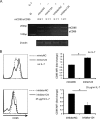Interleukin 7 up-regulates CD95 protein on CD4+ T cells by affecting mRNA alternative splicing: priming for a synergistic effect on HIV-1 reservoir maintenance
- PMID: 25411246
- PMCID: PMC4281737
- DOI: 10.1074/jbc.M114.598631
Interleukin 7 up-regulates CD95 protein on CD4+ T cells by affecting mRNA alternative splicing: priming for a synergistic effect on HIV-1 reservoir maintenance
Abstract
Interleukin-7 (IL-7) has been used as an immunoregulatory and latency-reversing agent in human immunodeficiency virus type 1 (HIV-1) infection. Although IL-7 can restore circulating CD4(+) T cell counts in HIV-1-infected patients, the anti-apoptotic and proliferative effects of IL-7 appear to benefit survival and expansion of HIV-1-latently infected memory CD4(+) T lymphocytes. IL-7 has been shown to elevate CD95 on CD4(+) T cells in HIV-1-infected individuals and prime CD4(+) T lymphocytes to CD95-mediated proliferative or apoptotic signals. Here we observed that through increasing microRNA-124, IL-7 down-regulates the splicing regulator polypyrimidine tract binding protein (PTB), leading to inclusion of the transmembrane domain-encoding exon 6 of CD95 mRNA and, subsequently, elevation of CD95 on memory CD4(+) T cells. Moreover, IL-7 up-regulates cellular FLICE-like inhibitory protein (c-FLIP) and stimulates c-Jun N-terminal kinase (JNK) phosphorylation, which switches CD95 signaling to survival mode in memory CD4(+) T lymphocytes. As a result, co-stimulation through IL-7/IL-7R and FasL/CD95 signal pathways augments IL-7-mediated survival and expansion of HIV-1-latently infected memory CD4(+) T lymphocytes. Collectively, we have demonstrated a novel mechanism for IL-7-mediated maintenance of HIV-1 reservoir.
Keywords: Alternative Splicing; CD95; Human Immunodeficiency Virus (HIV); Interleukin; MicroRNA (miRNA); PTB; Post-transcriptional Regulation.
© 2015 by The American Society for Biochemistry and Molecular Biology, Inc.
Figures






Similar articles
-
Blocking Formation of the Stable HIV Reservoir: A New Perspective for HIV-1 Cure.Front Immunol. 2019 Aug 22;10:1966. doi: 10.3389/fimmu.2019.01966. eCollection 2019. Front Immunol. 2019. PMID: 31507594 Free PMC article. Review.
-
Type I interferon upregulates Bak and contributes to T cell loss during human immunodeficiency virus (HIV) infection.PLoS Pathog. 2013;9(10):e1003658. doi: 10.1371/journal.ppat.1003658. Epub 2013 Oct 10. PLoS Pathog. 2013. PMID: 24130482 Free PMC article. Clinical Trial.
-
Killing of Latently HIV-Infected CD4 T Cells by Autologous CD8 T Cells Is Modulated by Nef.Front Immunol. 2018 Sep 11;9:2068. doi: 10.3389/fimmu.2018.02068. eCollection 2018. Front Immunol. 2018. PMID: 30254642 Free PMC article.
-
T helper type 1/T helper type 2 cytokines and T cell death: preventive effect of interleukin 12 on activation-induced and CD95 (FAS/APO-1)-mediated apoptosis of CD4+ T cells from human immunodeficiency virus-infected persons.J Exp Med. 1995 Dec 1;182(6):1759-67. doi: 10.1084/jem.182.6.1759. J Exp Med. 1995. PMID: 7500020 Free PMC article.
-
Interleukin-7 (IL-7): immune function, involvement in the pathogenesis of HIV infection and therapeutic potential.Eur Cytokine Netw. 2004 Oct-Dec;15(4):279-89. Eur Cytokine Netw. 2004. PMID: 15627636 Review.
Cited by
-
Differentiation into an Effector Memory Phenotype Potentiates HIV-1 Latency Reversal in CD4+ T Cells.J Virol. 2019 Nov 26;93(24):e00969-19. doi: 10.1128/JVI.00969-19. Print 2019 Dec 15. J Virol. 2019. PMID: 31578289 Free PMC article.
-
Alternative Splicing of Pre-mRNA in the Control of Immune Activity.Genes (Basel). 2021 Apr 15;12(4):574. doi: 10.3390/genes12040574. Genes (Basel). 2021. PMID: 33921058 Free PMC article. Review.
-
SMAC Mimetics Induce Autophagy-Dependent Apoptosis of HIV-1-Infected Resting Memory CD4+ T Cells.Cell Host Microbe. 2018 Nov 14;24(5):689-702.e7. doi: 10.1016/j.chom.2018.09.007. Epub 2018 Oct 18. Cell Host Microbe. 2018. PMID: 30344003 Free PMC article.
-
Sequence determinants as key regulators in gene expression of T cells.Immunol Rev. 2021 Nov;304(1):10-29. doi: 10.1111/imr.13021. Epub 2021 Sep 5. Immunol Rev. 2021. PMID: 34486113 Free PMC article. Review.
-
miRNA-124 in Immune System and Immune Disorders.Front Immunol. 2016 Oct 4;7:406. doi: 10.3389/fimmu.2016.00406. eCollection 2016. Front Immunol. 2016. PMID: 27757114 Free PMC article. Review.
References
-
- Schluns K. S., Kieper W. C., Jameson S. C., Lefrançois L. (2000) Interleukin-7 mediates the homeostasis of naive and memory CD8 T cells in vivo. Nat. Immunol. 1, 426–432 - PubMed
-
- Seddon B., Tomlinson P., Zamoyska R. (2003) Interleukin 7 and T cell receptor signals regulate homeostasis of CD4 memory cells. Nat. Immunol. 4, 680–686 - PubMed
Publication types
MeSH terms
Substances
LinkOut - more resources
Full Text Sources
Other Literature Sources
Medical
Research Materials
Miscellaneous

